Herbal plants are a delight and must have in every garden. Known for their hardy nature, low pest issues, various health benefits and easy growing ways, medicinal plants attract biodiversity and become your guide to the plant world. We have drawn up a list of common Ayurvedic and herbal plants that you can start planting immediately along with their uses in your garden.
Herbal plants are a delight and must have in every garden. Known for their hardy nature, low pest issues, various health benefits and easy growing ways, medicinal plants attract biodiversity and become your guide to the plant world. We have drawn up a list of common Ayurvedic and herbal plants that you can start planting immediately along with their uses in your garden.

AMRUTABALLI/ GILOY/ MOONLEAF
Scientific name: Tinospora Cordifolia
An Immunity boosting creeper, this vertical growing species is best known for many its immunity boosting properties. You can grow just from a cutting as it propagates easily. The heart shaped leaves grow well in full sun and tolerant of low light. Commonly found along footpaths and roadsides, a versatile medicinal species that comes loaded with health benefits. It even adds to aesthetics and is preferred for its beautiful sweeping look. Watering once in 2 days in full sun recommended, full drained ready soil, (optional) add a fertiliser once in two months, harvest leaves regularly. The flowers sprout once in 6-8 months.
In the Garden: Enjoys morning sun, aesthetics, plant in pot size of 12 inches, give support for climbing
How to Use: Leaves can be eaten directly, stems can be made into decoction
 BRAHMI/ INDIAN PENNYWORT
BRAHMI/ INDIAN PENNYWORT
Scientific name: Bacopa Monnieri
A water loving wide leaf species, this medicinal plant is slightly sour, excellent for acidity, known to increase memory and concentration. Give it a shallow wide container and full sun, pick the leaves and eat directly. High in medicinal properties, can be grown from a cutting,
In the Garden: Loves a wet soil, fast growing. Grows well in the company of other plants, likes a shallow and wide container, grows horizontally
How to use: Know to be memory booster
 SESSILE JOYWEED/ HONGONE SOPPU
SESSILE JOYWEED/ HONGONE SOPPU
Scientific name: Alternanthera Sessilis
Very common in many gardens, commonly mistaken for a weed, this Ayurvedic plant in fact is loaded with Vitamins and makes a tasty vegetable. Called Hongone soppu in Kannada and found commonly in empty spaces, abandoned land, on roads etc a common sight. comes in green and purple, grow in your garden harvest and consume. The flowers have thorns so be careful while picking.
In the Garden: They make a great foliage growing plant and add greenery, do well as mulch too, use in the kitchen.
How to use: In palya’s and soppus, even salads, iron rich and healthy
 CURRY LEAF/ KARIBEVU/ KARIPATTA
CURRY LEAF/ KARIBEVU/ KARIPATTA
Scientific name: Moraya Koengii
A common plant in many gardens, extremely high in Ayurveda this fragrantly spicy herb all parts can be used, from stem to leaves flowers and even the black fruits. An anti-bacterial, induces heat, high vitamins and high in iron, even known to be excellent for hair growth
In the Garden: A biodiversity attractor for the common Mormon butterfly, this species grows from low to full sun, enjoys a good drenching of diluted buttermilk in water every now and then, remember to harvest regularly and give it a large container at least 12 inches in diameter
How to use: A common green spice in tempering for chutneys, gravies etc
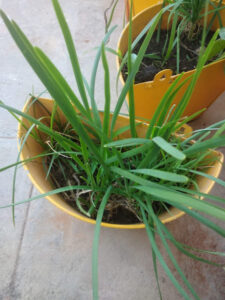 GARLIC CHIVES
GARLIC CHIVES
Scientific name: Allium tuberosum
Aromatic and easy to grow, this is propagated through seeds, a perennial variety, so continuous harvest is encouraged to control maturation. Garlic is great for the system, one of the best immunity boosting herbs, known to strengthen the heart.
In the Garden: The flowers attract the honeybees, grow it in between other plants as a pest solution, garlic smell cannot be tolerated by most insects so pest is no problem. Use like spring onions for culinary. To propagate and sustain, sprinkle the mature seeds on top of soil, they grow fast and you get harvests all through the year
How to use: In soups, stir fries or garnish for that extra garlic taste and aroma
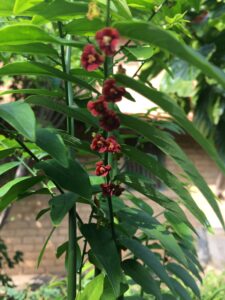 MULTIVITAMIN/ CHEKARAMUNI/ SWEET LEAF PLANT
MULTIVITAMIN/ CHEKARAMUNI/ SWEET LEAF PLANT
Scientific name: Saurupus Androgynus
Native to South East Asia, Packed with Vitamins A,B,C this sweet tasting leaf is one hardy versatile variety that grows like a tree and highly recommended to grow and maintain in a garden. You can harvest this regularly, every few days and new leaves will keep emerging. Pest attacks are rare, it grows well under a full sun, even in shade it does fine
In the Garden: A nitrogen fixer, the extra green leafy bits and other dried parts make excellent mulch for the garden, always better to give it a large container at least 15-16 inches wide, the roots go deep and the plant grows tall like a tree. Pick and eat the leaves raw regularly, the small pink fruits/ seeds can also be consumed. The stems taste like asparagus. Talk about getting all your vitamins at a Go!
How to use: Leaves can be eaten directly, added in soups and salads, make a vegetable
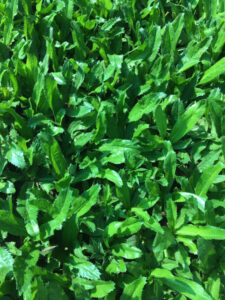 LONG (NAATI) CORIANDER /MEXICAN CORIANDER
LONG (NAATI) CORIANDER /MEXICAN CORIANDER
Scientific name: Eryngium foetidm
This kind of Coriander is sharper and its long salad like leaves is excellent to grow in gardens. High in medicinal value and used for various ailments, this sharp tasting herb is known to calms the nerves, anxiety.
In the Garden –Give this one full sun, a shallow container of 4-5 inches is fine, plant with other plants and harvest as you go. Seeds are powdery, sprinkle in new pots and get these greens all year around
How to use: Marinade or use as salad
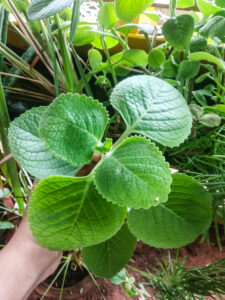 INDIAN OREGANO/ AJWAIN/ DODDAPATRE
INDIAN OREGANO/ AJWAIN/ DODDAPATRE
Scientific name: Trachyspermum ammi
Extremely common in many Garden households, this aromatic and pungent tasting herb does well in indirect light and low sunlight spots. Easy and hard to kill, it grows quickly and loves a well-drained vermin rich soil. You can propagate this through cuttings in glass bottles and once the roots emerge, transfer to soil. Great for keeping colds, congestion and change of weather blues away.
In The Garden – Thrives in low/ indirect light, a slightly humid atmosphere suits this variety
How to use: Keeps coughs and colds at bay, add chopped to hot water and drink, fry and eat, add to salads
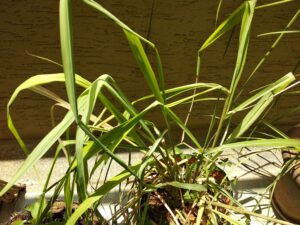 LEMONGRASS
LEMONGRASS
Scientific name: Cymbopogon citratus
Lemongrass is excellent to grow in gardens, it removes mosquitoes, aromatic and can be used in various culinary and beverage preparations. Native to South East regions Cambodia, Vietnam, Sri Lanka, Thailand
In the Garden – Full sun required, regular watering, a large container or plant directly into the ground.
How to use – Use in South east Asian cuisine, beverages
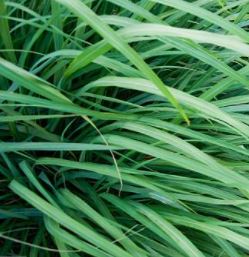 CITRONELLA
CITRONELLA
Scientific name:Cymbopogon Nardus
Citronella is excellent to grow in gardens, it removes mosquitoes, aromatic and can be used in various culinary and beverage preparations. Native to South East regions Cambodia, Vietnam, Sri Lanka, Thailand
In the Garden – Full sun required
How to use – Mosquitoes and house flies hate the smell, use in aromatherapy, floor cleaning, plant outside your window
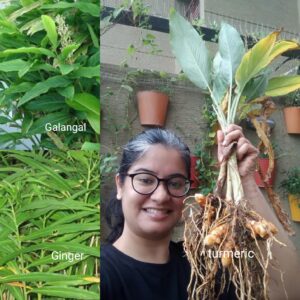 MEET THE RHIZOME FAMILY – TURMERIC, GINGER, GALANGAL (THAI GINGER)
MEET THE RHIZOME FAMILY – TURMERIC, GINGER, GALANGAL (THAI GINGER)
Scientific name: Curcurma Longa, Zinziber Officinale, Alpinia Galangal
These rhizomes love full sun and open air, a well-drained soil and regular watering. Taking anywhere between 8 months to grow, the leaves can be used and the flowers are aromatic and bring in lots of insects into the garden. Native to South East Asia, India, Sri Lanka and some of the most widely used ingredients in Asian kitchens
In the Garden – Thrives in full sun, well drained soil, leaves can be used, takes anywhere between 8 -11 months to be ready
How to use – Culinary preparations, leaves can be used for steaming
References
Photo Guide to Selected Medicinal Plants of Karnataka by K.Ravikumar R. Vijayasankar R. Murugan, G.S Goraya & S. Noorunnisa Begam
Cities and Canopies Trees in Indian Cities By Harini Nagendra and Seema Mundoli
The World Book Encyclopaedia
SHOP FOR HERBAL SAPLINGS HERE!
Related Experiences
- August 15, 2024
- 7:30 AM to 9:30 AM
- Indira Gandhi (Fountain) Park
- April 20, 2024
- 7:30 am to 9:30 am
- Cubbon Park
